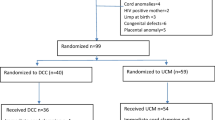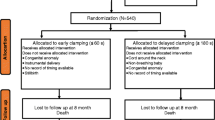Abstract
Background and Aim
Umbilical cord milking (UCM) has been theorized to increase placental blood transfusion then again, the optimal method of cord clamping at birth is still contested. We aimed to analyse the effects of UCM on the neonatal haematological parameters at 72 h and 6 weeks of age and its association with any adverse effects.
Materials and Methods
In this randomized control trial, mothers ≥ 34 weeks were randomized into two arms. Under the intervention group, the cord was milked three times before clamping and cutting whereas the controls had the cord clamped and cut without milking. Haemoglobin and haematocrit levels were measured at 72 h. and at 6 weeks.
Results
A total of 170 mothers were enrolled with 85 subjects in each arm. Baseline characteristics were comparable. In the intervention arm, the mean haemoglobin [18.1 (2.4) g/dL] and haematocrit [54 (7) %] were significantly higher as compared to the control arm [16.4 (2.1) g/dL and 48 (6) %], at 72 h of age. There was also significant increase in the mean haemoglobin [11.6 (1.3) g/dL] and haematocrit [34 (4) %] compared to the controls [10.1 (1.1) g/dL and 30 (3) %], at 6 weeks. No statistical difference was found in the incidence of PPH and duration of third stage. There was no significant rise in hyperbilirubinaemia, phototherapy requirement and polycythaemia among neonates in the intervention group.
Conclusion
Umbilical cord milking is a sound practical approach to raise the haemoglobin and haematocrit levels up to 6 weeks thereby decreasing the proportion of anaemic infants.


Similar content being viewed by others
References
Hosono S, Hine K, Nagano, N et al. Residual blood volume in the umbilical cord of extremely premature infants. Pediatr Int. 2015;57(1):68–71.
Basile S, Pinelli S, Micelli E, et al. Milking of the umbilical cord in term and late preterm infants. Biomed Res Int. 2019;11(2019):1–9.
Al-Wassia H, Shah PS. Efficacy and safety of umbilical cord milking at birth: a systematic review and meta-analysis. JAMA Pediatr. 2015;169(1):18–25.
Upadhyay A, Gothwal S, Parihar R, et al. Effect of umbilical cord milking in term and near term infants: randomized control trial. Am J Obstet Gynecol. 2013;208(2):120.e1-120.e6.
Wang M. Iron deficiency and other types of anemia in infants and children. AFP. 2016;93(4):270–8.
Alzaree F, Elbohoty A, Abdellatif M. Early versus delayed umbilical cord clamping on physiologic anemia of the term newborn infant. Open Access Maced J Med Sci. 2018;6(8):1399–404.
Song S-Y, Kim Y, Kang B-H, et al. Safety of umbilical cord milking in very preterm neonates: a randomized controlled study. Obstet Gynecol Sci. 2017;60(6):527–34.
Katheria AC, Truong G, Cousins L, et al. Umbilical cord milking versus delayed cord clamping in preterm infants. Pediatrics. 2015;136(1):61–9.
Katheria A, Garey D, Truong G, et al. A randomized clinical trial of umbilical cord milking vs delayed cord clamping in preterm infants: neurodevelopmental outcomes at 22–26 months of corrected age. J Pediatr. 2018;194:76–80.
Olatunya OS, Olu-Taiwo A, Ogundare EO, et al. Evaluation of a portable haemoglobin metre performance in children with sickle cell disease and implications for healthcare in resource-poor settings. J Trop Pediatr. 2016;62(4):316–23.
Olatunya O, Ogundare O, Olaleye A, et al. Point-of-care testing for anaemia in children using portable haematocrit meter: a pilot study from Southwest Nigeria and implications for developing countries. Ethiop J Health Sci. 2016;26(3):251–8.
Onyeneho NG, Ozumba BC, Subramanian SV. Determinants of childhood Anemia in India. Sci Rep. 2019;9(1):16540.
Zanardo V, Guerrini P, Severino L, et al. A randomized controlled trial of intact cord milking versus immediate cord clamping in term infants born by elective cesarean section. Am J Perinatol. 2019;0039:1697673.
Yadav AK, Upadhyay A, Gothwal S, et al. Comparison of three types of intervention to enhance placental redistribution in term newborns: randomized control trial. J Perinatol. 2015;35(9):720–4.
Jaiswal P, Upadhyay A, Gothwal S, et al. Comparison of two types of intervention to enhance placental redistribution in term infants: randomized control trial. Eur J Pediatr. 2015;174(9):1159–67.
Chiruvolu A, Medders A, Daoud Y. Effects of umbilical cord milking on term infants delivered by cesarean section. Am J Perinatol. 2020;0040:1701617.
Agarwal S, Jaiswal V, Singh D, et al. Randomised control trial showed that delayed cord clamping and milking resulted in no significant differences in iron stores and physical growth parameters at one year of age. Acta Paediatr. 2016;105(11):e526–30.
Balasubramanian H, Ananthan A, Jain V, et al. Umbilical cord milking in preterm infants: a systematic review and meta-analysis. Arch Dis Child Fetal Neonatal Ed. 2020;105(6):572–80.
Vogel JP, Williams M, Gallos I, et al. WHO recommendations on uterotonics for postpartum haemorrhage prevention: what works, and which one? BMJ Glob Health. 2021;4(2). https://www.ncbi.nlm.nih.gov/pmc/articles/PMC6509591/
Piyadigama I, Devasurendra LC, Dissanayake AD, Gunawardana K. Effects of umbilical cord milking compared to differed cord clamping in term infants, a randomized controlled trial. Sri Lanka J Obstetr Gynaecol. 2017;39(4):63.
Acknowledgements
The trial was registered prospectively under the Clinical Trial Registry of India. (CTRI/2017/10/009970).
Author information
Authors and Affiliations
Corresponding author
Ethics declarations
Conflict of interest
Both authors declare that they have no conflict of interest.
Human and Animal Right Statements
All procedures followed were in accordance with the ethical standards of the responsible committee on human experimentation and with Helsinki Declaration 1975, as revised in 2008.
Ethical Standards
This study was approved by the institutional ethical committee.
Informed Consent
Informed consent was obtained from all mothers for being included in the study.
Additional information
Publisher's Note
Springer Nature remains neutral with regard to jurisdictional claims in published maps and institutional affiliations.
Anu Anna George is an Assistant Professor, Department of OBG, MOSC Medical College, Kolenchery. Mini Isac is an Professor, Department of OBG, MOSC Medical College, Kolenchery.
Rights and permissions
About this article
Cite this article
George, A.A., Isac, M. Effect of Umbilical Cord Milking on Maternal and Neonatal Outcomes in a Tertiary Care Hospital in South India: A Randomized Control Trial. J Obstet Gynecol India 72, 291–298 (2022). https://doi.org/10.1007/s13224-021-01515-9
Received:
Accepted:
Published:
Issue Date:
DOI: https://doi.org/10.1007/s13224-021-01515-9




